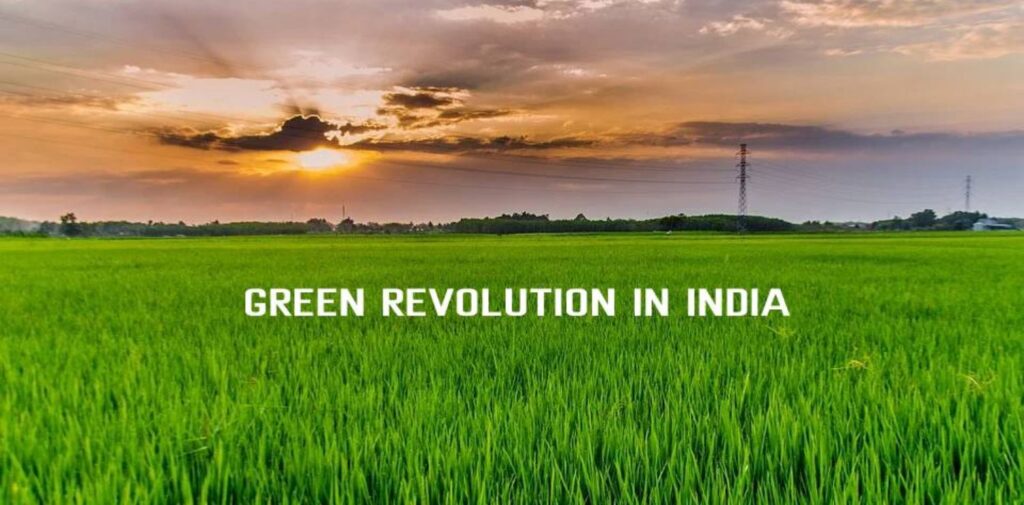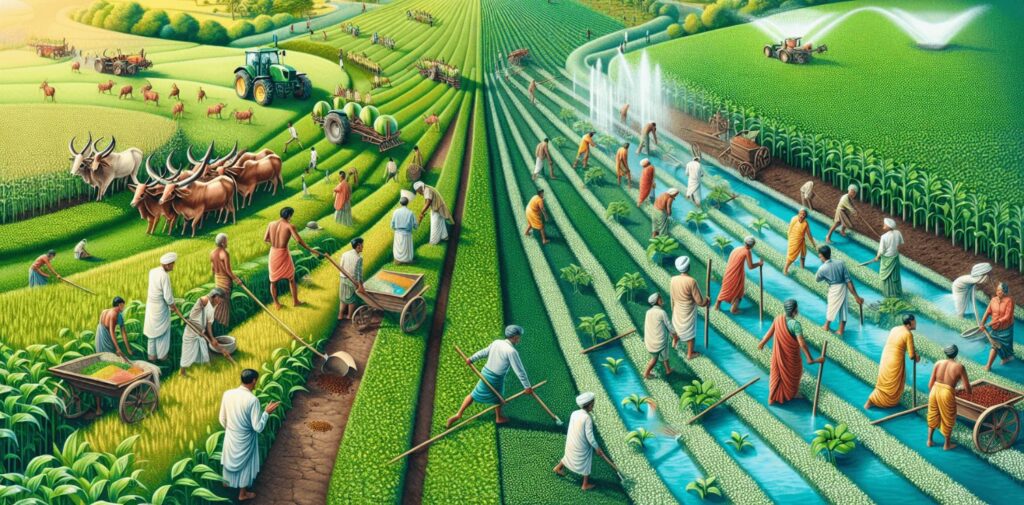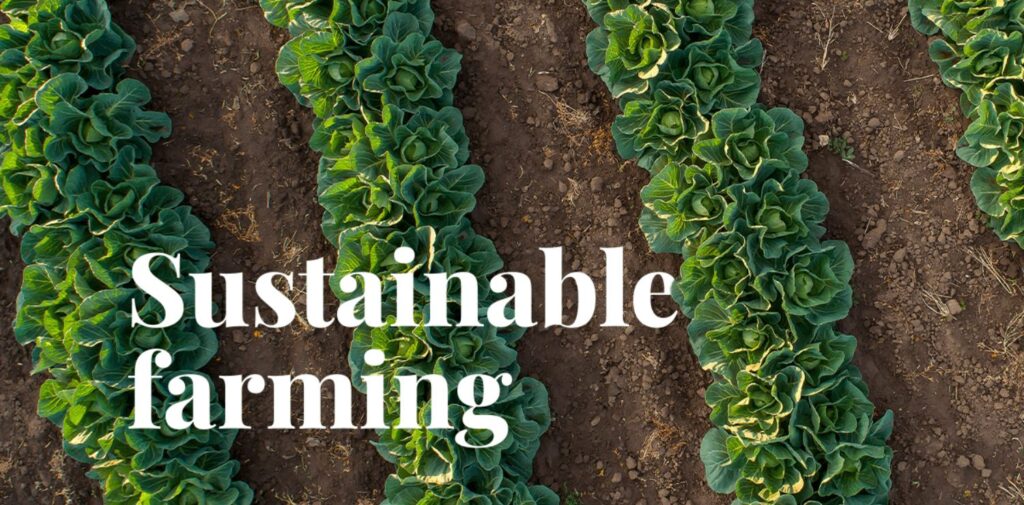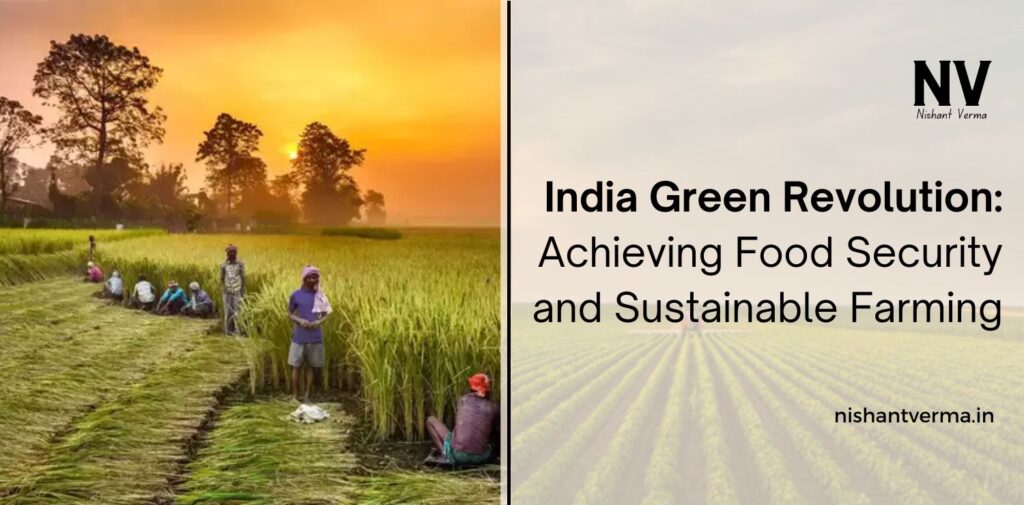India Green Revolution is one of the most significant agricultural movements in modern history. It transformed India from a country struggling with food shortages to a nation capable of feeding its vast population. The Green Revolution in India was a series of research, development, and technology adoption initiatives in agriculture, primarily during the 1960s and 1970s. Its goal was to increase food production to ensure food security for India’s growing population. In this article, we will explore how the Green Revolution achieved food security and the lessons it provides for sustainable farming practices.
Background of the Green Revolution in India
Before the Green Revolution, India faced severe food shortages. The country was heavily dependent on imports to meet its food needs. In the 1940s and 1950s, the country experienced frequent famines and hunger, with a large portion of the population unable to access enough food. The problem was compounded by a growing population, poor agricultural productivity, and a lack of modern farming practices.
India’s agricultural system was traditional, with farmers relying on outdated methods and tools. The yields were low, and the land was not used efficiently. In the 1950s and 1960s, the country faced serious challenges in producing enough food to feed its people. It was at this time that India turned to scientific advancements and modern agricultural techniques to boost food production.

Birth of the Green Revolution
The Green Revolution in India was largely influenced by advancements in agricultural science, especially the development of high-yielding varieties (HYVs) of crops, particularly wheat and rice. In the 1960s, Indian agricultural scientists and policymakers began to look for solutions to improve food production. They received support from international organizations such as the Ford Foundation and the Rockefeller Foundation, which helped fund research into new farming technologies.
The Green Revolution was first introduced to India by Dr. M. S. Swaminathan, an agricultural scientist who is often referred to as the “Father of the Green Revolution in India.” He worked closely with international experts and brought in new crop varieties, improved irrigation techniques, and modern farming practices.
The Green Revolution involved the following key elements:
- High-Yielding Varieties (HYVs): The introduction of HYVs of crops, such as wheat and rice, played a crucial role in increasing food production. These varieties were designed to produce higher yields per acre compared to traditional varieties. These crops required more water and fertilizers but offered higher productivity in return.
- Chemical Fertilizers and Pesticides: The use of chemical fertilizers, such as nitrogen, phosphorus, and potassium, helped increase the fertility of the soil and boosted crop growth. Pesticides were also used to protect crops from pests and diseases.
- Irrigation: The Green Revolution emphasized the need for efficient irrigation systems to ensure that crops received a sufficient amount of water. Irrigation infrastructure, such as dams and canals, was improved, allowing farmers to grow crops in areas that were previously unsuitable for agriculture.
- Mechanization: The introduction of modern machinery, such as tractors, ploughs, and harvesters, helped farmers increase productivity and reduce labour costs. Mechanization made it possible to cultivate larger areas of land and harvest crops more efficiently.
- Training and Extension Services: The Green Revolution also focused on educating farmers about new techniques and technologies. Agricultural extension services were set up to train farmers and provide them with the knowledge needed to adopt modern farming practices.

Achieving Food Security
The Green Revolution succeeded in increasing food production and improving food security in India. The immediate impact of the Green Revolution was seen in the increase in the production of staple crops like wheat and rice. India, which had once relied heavily on food imports, became self-sufficient in food production by the early 1970s. In fact, India’s wheat production increased from 10.5 million tons in 1960 to over 70 million tons by the early 1980s.
The Green Revolution’s contribution to food security can be seen in the following ways:
- Increased Crop Yields: The introduction of HYVs, combined with better irrigation, fertilizers, and pesticides, resulted in higher yields. Farmers could now grow more food on the same amount of land. This allowed India to produce enough food to feed its growing population.
- Reduction in Hunger and Malnutrition: With increased food production, India was able to reduce hunger and malnutrition, especially in rural areas. The increased availability of food helped improve the nutritional status of the population.
- Improvement in Rural Economies: The Green Revolution led to increased incomes for farmers, especially those who adopted modern farming techniques. This contributed to the overall improvement of rural economies and the standard of living for many farmers.
- Self-Sufficiency in Food: India became self-sufficient in major crops like wheat and rice, reducing its dependence on food imports. This helped the country save foreign exchange and boosted its agricultural exports.
Environmental and Social Challenges
While the Green Revolution was successful in increasing food production and achieving food security, it also brought about several environmental and social challenges. Some of the key issues include:
- Overuse of Chemicals: The widespread use of chemical fertilizers and pesticides led to soil degradation and water pollution. The chemicals, if not used properly, could harm the environment and human health. Over time, the soil became less fertile due to the depletion of natural nutrients.
- Water Depletion: The Green Revolution relied heavily on irrigation, especially in regions like Punjab, Haryana, and Uttar Pradesh. Over-extraction of groundwater for irrigation has led to the depletion of water resources in some areas, making farming unsustainable in the long run.
- Increased Inequality: While the Green Revolution benefited many farmers, particularly those with access to modern technology, it also led to increased inequality. Wealthier farmers who could afford new technologies and inputs gained the most, while poorer farmers were left behind. This created a divide between rich and poor farmers.
- Loss of Biodiversity: The focus on a few high-yielding crops led to a reduction in biodiversity. Traditional crop varieties were replaced with HYVs, reducing the genetic diversity of crops and making them more vulnerable to pests, diseases, and climate change.

Sustainable Farming in the Aftermath of the Green Revolution
Given the challenges posed by the Green Revolution, there has been a growing emphasis on sustainable farming practices in India. Sustainable farming aims to produce enough food while minimizing the negative environmental and social impacts. Some of the key elements of sustainable farming include:
- Organic Farming: Organic farming promotes the use of natural fertilizers, crop rotations, and pest control methods that do not harm the environment. Organic farming helps restore soil health and reduces the harmful effects of chemical fertilizers and pesticides.
- Water Conservation: Sustainable farming practices include better water management techniques, such as drip irrigation, rainwater harvesting, and the use of water-efficient crops. These methods help conserve water and prevent the depletion of groundwater.
- Agroforestry: Agroforestry involves growing trees alongside crops to improve soil fertility, reduce soil erosion, and increase biodiversity. This practice provides farmers with additional sources of income and helps restore ecological balance.
- Climate-Smart Agriculture: With climate change becoming a growing concern, farmers are encouraged to adopt climate-smart agricultural practices. These include choosing drought-resistant crop varieties, improving water management, and reducing greenhouse gas emissions from agriculture.
- Support for Small Farmers: Sustainable farming also focuses on supporting small and marginal farmers, who are often left out of the benefits of modern agriculture. Providing them with access to technology, credit, and training can help improve their livelihoods and promote inclusive growth.
Conclusion: India Green Revolution
The Green Revolution played a crucial role in achieving food security in India by increasing agricultural production and reducing hunger. However, it also highlighted the need for more sustainable and inclusive farming practices. While the Green Revolution helped India become self-sufficient in food production, the environmental and social challenges it created need to be addressed for long-term sustainability. By promoting sustainable farming practices, India can continue to ensure food security for its growing population while protecting the environment for future generations.




